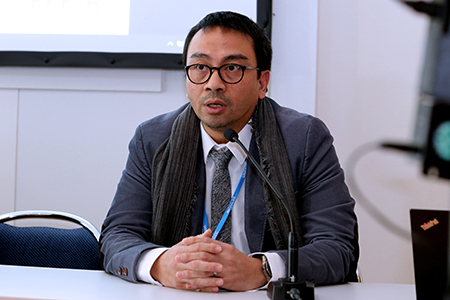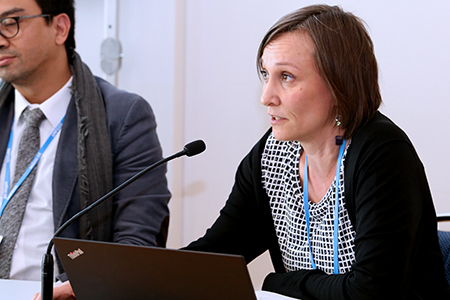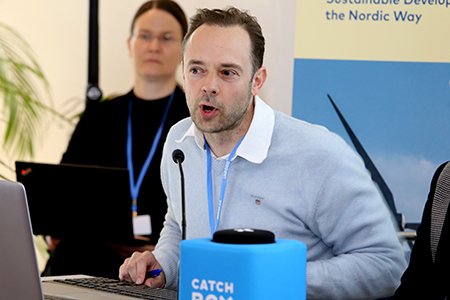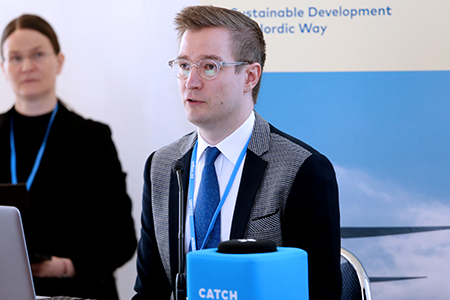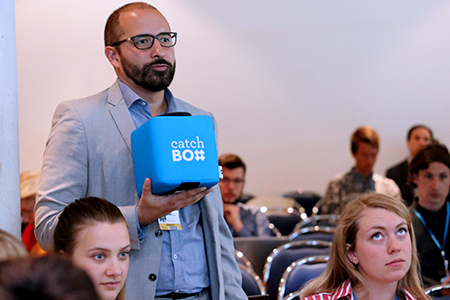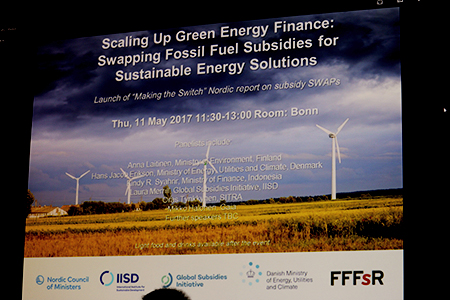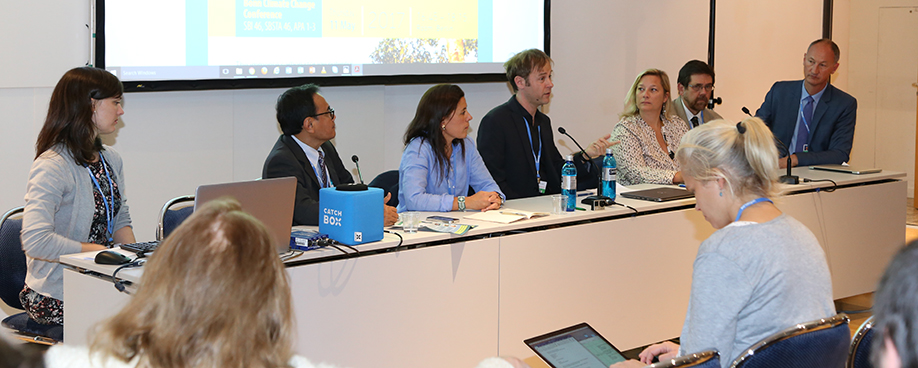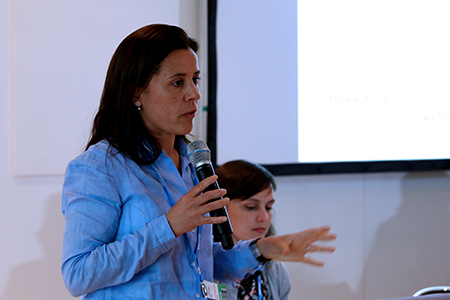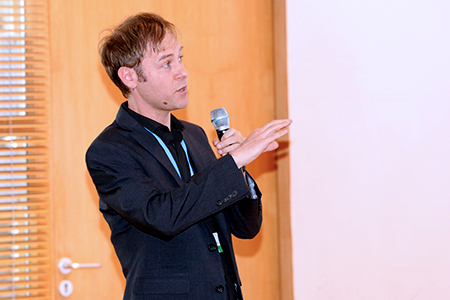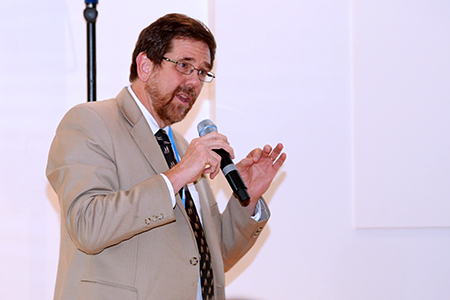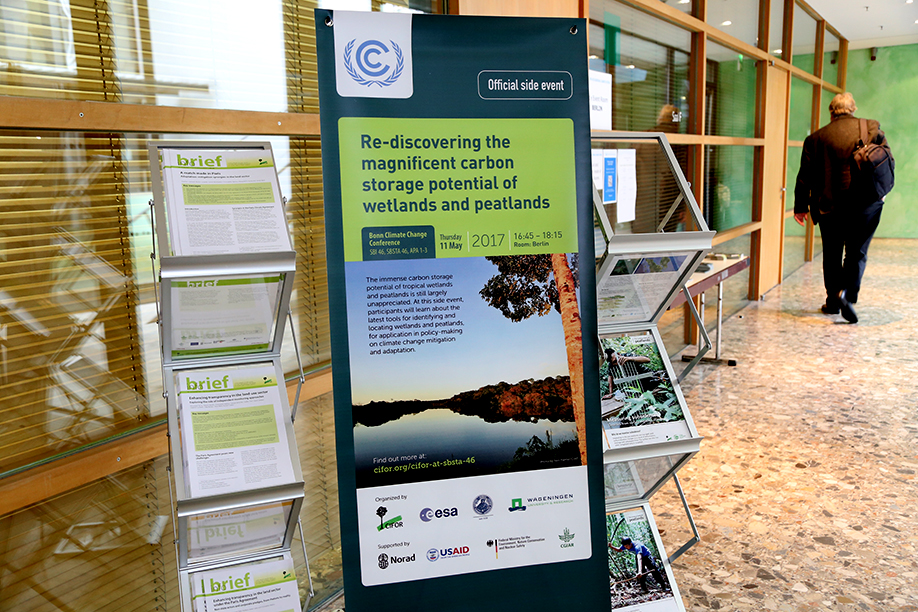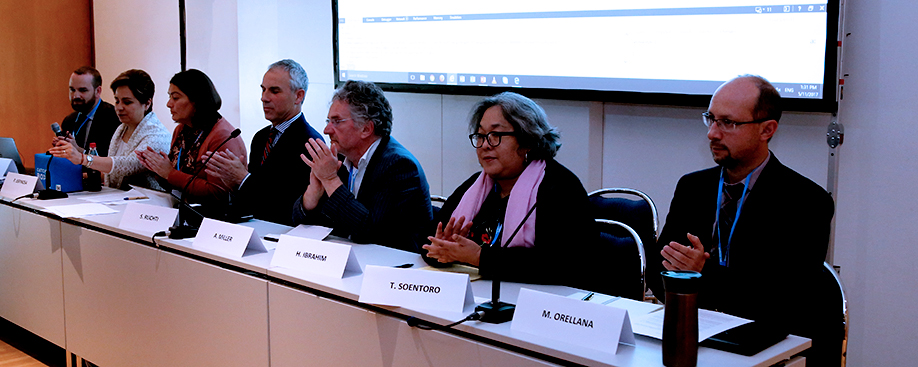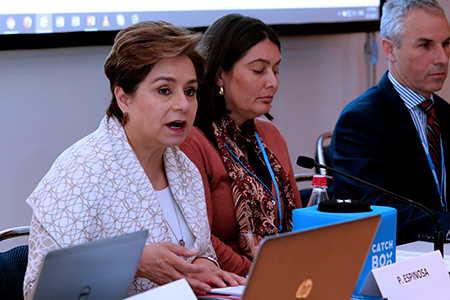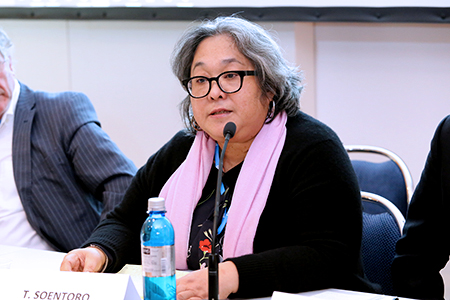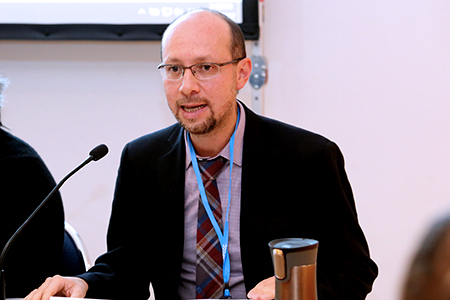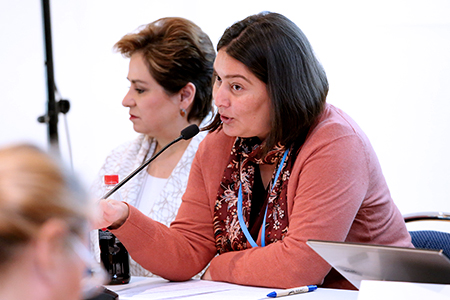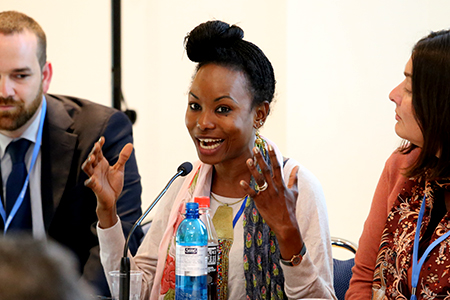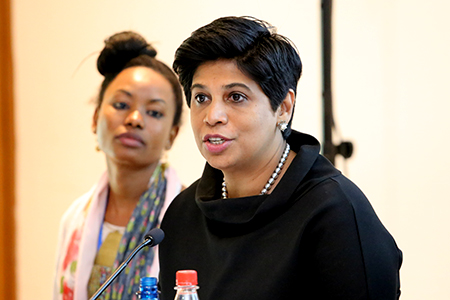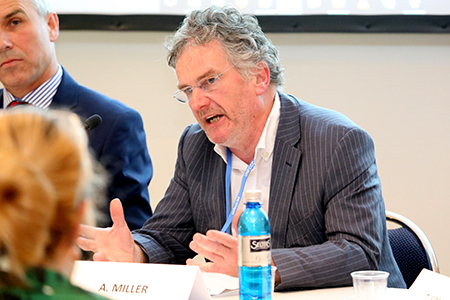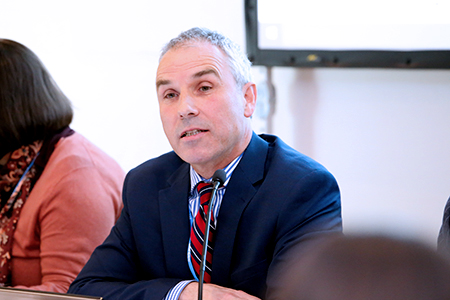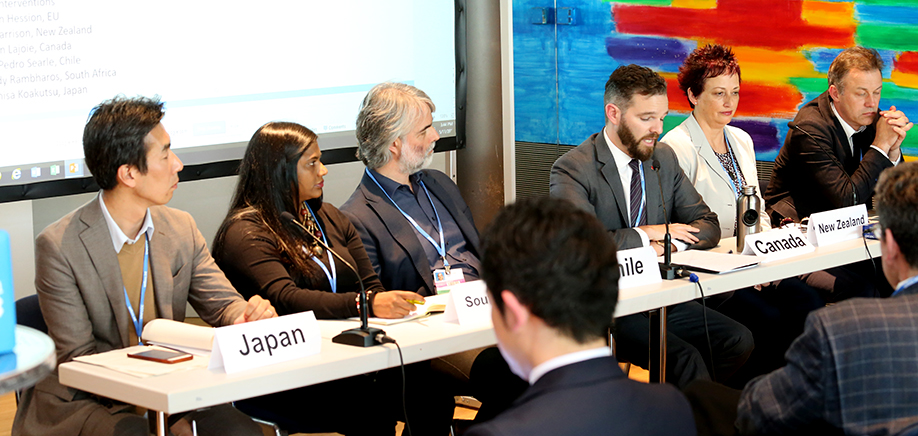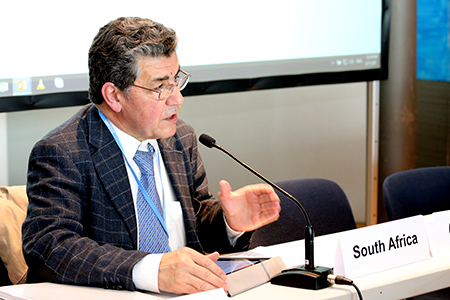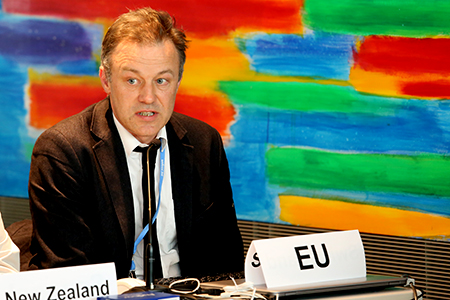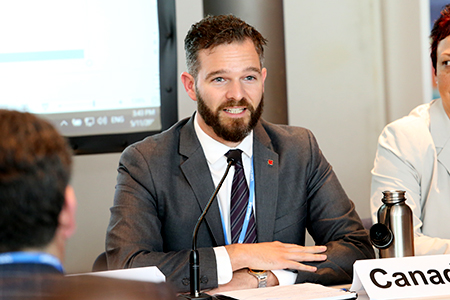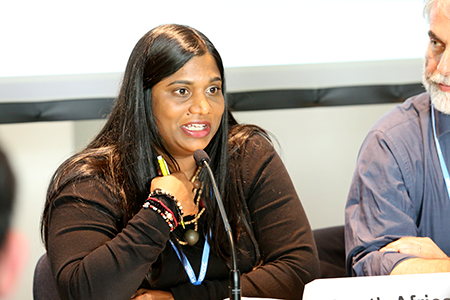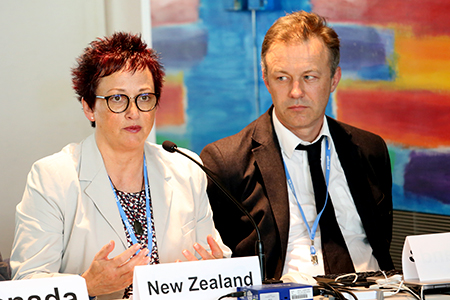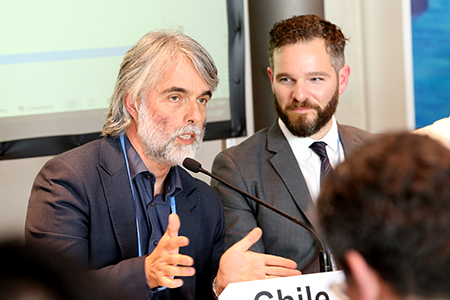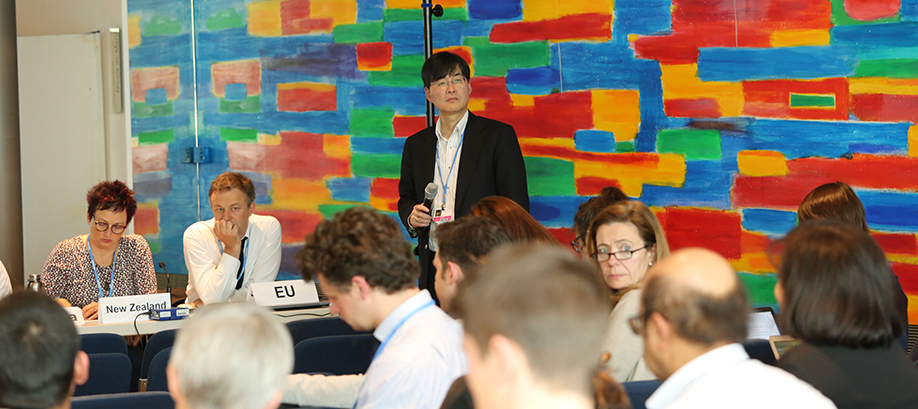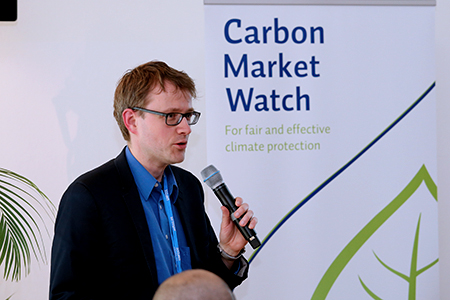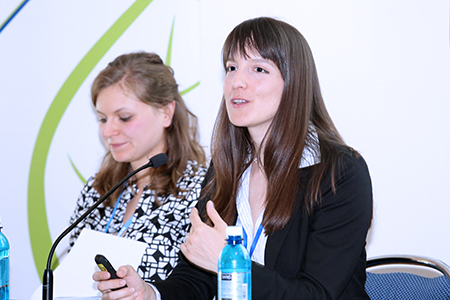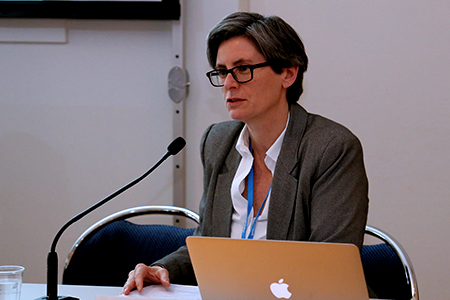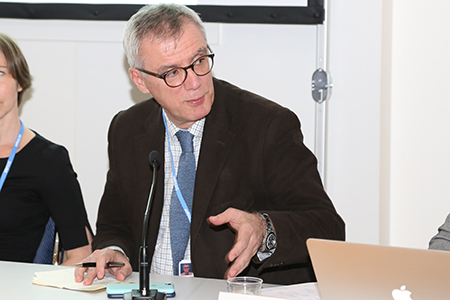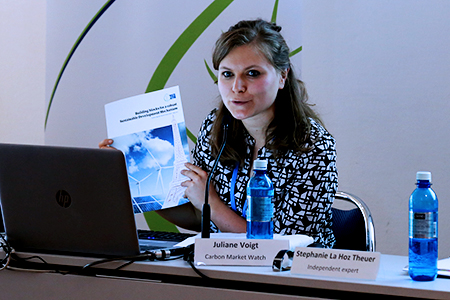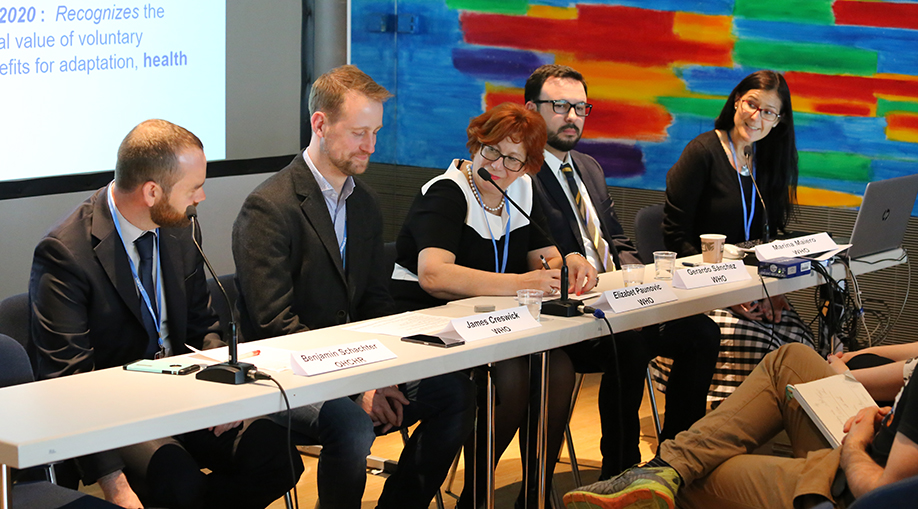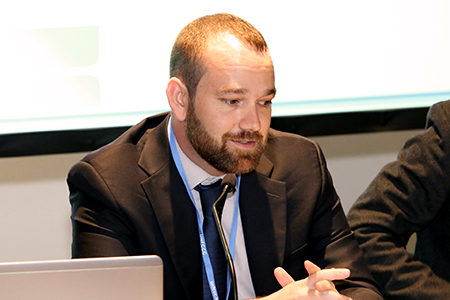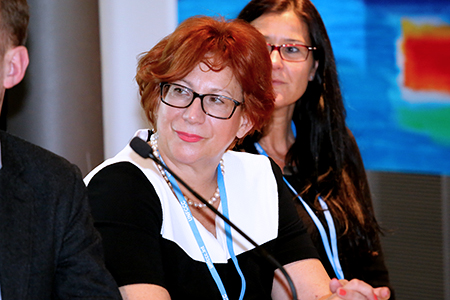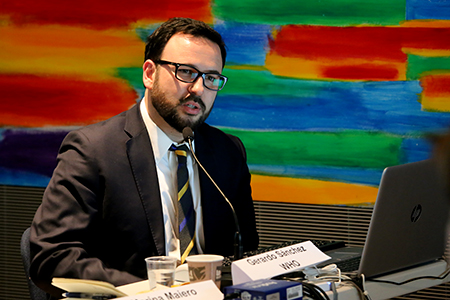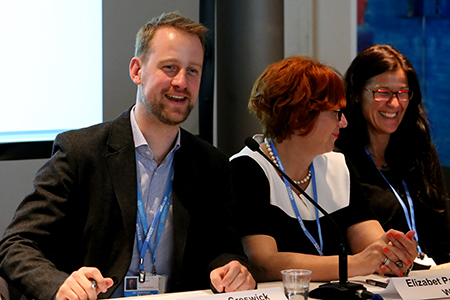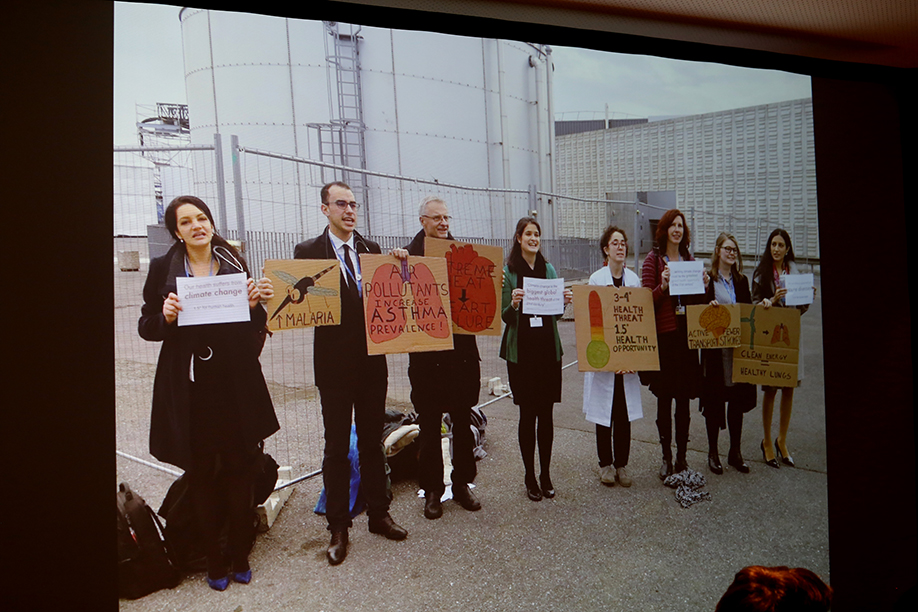Summary
The following side events were covered by ENBOTS on Thursday, 11 May 2017:
- Scaling Up Green Energy Finance: Swapping Fossil Fuel Subsidies for Sustainable Energy Solutions
- Re-discovering the Lost Magnificent Carbon Storage in Wetlands
- Integrating Human Rights into Climate Action after Paris
- Mitigation Action through Article 6 of the Paris Agreement
- Ensuring Integrity of Article 6 of the Paris Agreement – Challenges and Opportunities from a Civil Society Perspective
- Update on the Findings of the Health Impacts and Co-benefits of Climate Change
IISD Reporting Services, through its Earth Negotiations Bulletin on the Side (ENBOTS) Meeting Coverage, is providing daily web coverage of selected side events at the Bonn Climate Change Conference, May 2017.
Photos by IISD/ENB | Angeles Estrada Vigil
For photo reprint permissions, please follow instructions at our Attribution Regulations for Meeting Photo Usage Page
Scaling Up Green Energy Finance: Swapping Fossil Fuel Subsidies for Sustainable Energy SolutionsPresented by the International Institute for Sustainable Development (IISD), the Government of Denmark, the Nordic Council of Ministers (NCM) and the Friends of Fossil Fuel Subsidy Reform (FFFSR)
This session, moderated by Karoliina Anttonen, Ministry of Environment, Finland, focused on how governments can scale up investments in green energy by “making the switch” from fossil fuel subsidies to sustainable energy subsidies.
Highlighting the climate change mitigation, clean air and health benefits of fossil fuel subsidy reform, Hans Jakob Eriksen, Ministry of Energy, Utilities and Climate, Denmark, launched the report ‘Making the Switch from Fossil Fuel Subsidies to Sustainable Energy,’ funded by the NCM. He underlined that, in an “ideal world,” fossil fuel subsidies would be removed and reallocated to renewable energy and energy efficiency measures. He noted the feasibility of introducing reforms now, while oil prices are low.
Laura Merrill, Global Subsidies Initiatives (GSI), IISD, described the report as a “primer” on fossil fuel subsidies, underlining the scope of such subsidies is US$425 billion annually. Highlighting these subsidies’ “regressive” nature, she stressed that much more effective interventions exist to target the poor.
Kindy Syahrir, Ministry of Finance, Indonesia, noted that fossil fuel subsidies in his country currently represent just one tenth of what they used to be before reforms began in 2015. He underscored how the relevant funding is better spent on renewable energy, green infrastructure, health, education and other social programmes.
Oras Tynkkynen, Sitra, outlined findings by the Finnish innovation fund that scaling up existing solutions in both the global North and South could dramatically cut global greenhouse gas emissions. He said that the necessary investments could be financed by diverting “a fraction” of fossil fuel subsidies and invited interested countries to get in touch to explore the potential of existing climate solutions in their national contexts.
Noting that public finance needs to be used very efficiently, Mikko Halonen, Gaia Consulting, noted efforts by Nordic countries to operationalize and mobilize climate finance by facilitating investments through de-risking and enhancing the bankability of climate projects.
In the ensuing discussion, participants raised, inter alia: the relevance of fossil fuel subsidy reform in the redesign of countries’ Nationally Determined Contributions (NDCs); the need for a “vocabulary shift” that does not only emphasize fossil fuel subsidy reform, but also a reallocation of funds to finance sustainable development objectives; and challenges in defining “subsidies,” and what constitutes an “inefficient” subsidy. Participants also highlighted: “rent-seeking” with regard to fossil fuel subsidy policies; “the elephant in the room” of political economy; the need for a carbon price; and the need to take into account political realities and alignments in order to achieve successful reform.
(L-R): Oras Tynkkynen, Sitra; Mikko Halonen, Gaia Consulting; Hans Jakob Eriksen, Ministry of Energy, Utilities and Climate, Denmark; Laura Merrill, GSI, IISD; Kindy Syahrir, Ministry of Finance, Indonesia; and Karoliina Anttonen, Ministry of Environment, Finland
Kindy Syahrir, Ministry of Finance, Indonesia, highlighted how his country’s national energy targets can be financed through reform of fossil fuel subsidies, which until recently took up 35% of Indonesia’s budget.
Karoliina Anttonen, Ministry of Environment, Finland, moderated the event.
Mikko Halonen, Gaia Consulting, underlined that in addition to “switching off” old approaches, new solutions need to be “switched on” to achieve a sustainable and equitable social transformation.
Oras Tynkkynen, Sitra, highlighted that the equivalent of the combined emissions of France and the UK could be reduced if all countries used as much wind power as Denmark and Brazil, stressing the necessary investment in 2030 would cost just a month’s worth of direct fossil fuel subsidies.
Hans Jakob Eriksen, Ministry of Energy, Utilities and Climate, Denmark, stressed, “we are looking at very big opportunities, both from a financial and a climate mitigation perspective.”
Underscoring the challenges of financing the Sustainable Development Goals, Laura Merrill, IISD, urged fossil fuel subsidy reform and reallocation to help achieve these targets.
Arturo Balderas, University of Toronto
Contact:
- Laura Merrill (Organizer) | lmerrill@iisd.org
Hans Jakob Eriksen (Organizer) | hajae@efkm.dk
Anna Laitinen (Organizer) | anna.s.laitinen@ym.fi
More Information:
-
www.iisd.org/gsi
www.norden.org
http://urn.kb.se/resolve?urn=urn:nbn:se:norden:org:diva-4845greentoscale.net
Re-Discovering the Magnificent Carbon Storage Potential
of Wetlands and PeatlandsPresented by the Center for International Forestry Research (CIFOR), the European Space Agency (ESA) and the Friedrich Schiller University Jena (FSU Jena)
This event focused on the carbon storage potential of tropical wetlands and peatlands, and highlighted tools for the identification and location of such areas to assist climate policy making. Daniel Murdiyarso, CIFOR, moderated the event.
Rosa Maria Roman-Cuesta, CIFOR and Wageningen University and Research (WUR), presented on an expert system model underpinning a new global wetlands map with high spatial detail and a multisource approach, including satellite, climatic and topographic data. She noted that while numerous efforts have been made in the past to assess the extent of global wetlands, estimates in modeled area simulations varied four-fold.
Simon Lewis, Leeds University, shared findings from recent research, which suggests the Cuvette Centrale complex in the Congo Basin is the most extensive peatland complex in the tropics. While covering 5.4% of the Democratic Republic of Congo and Republic of Congo, he said this area stores as much carbon as all the vegetation in these two countries combined.
Frank Martin Seifert, ESA, highlighted the European Union’s Copernicus Programme, which, among other activities in the areas of environment and civil security, is helping to monitor and map peatlands from space. Noting the Programme’s free and open access data policy, he highlighted how ESA’s work in this area will support the Global Peatlands Initiative (GPI) including by improving mapping of degraded and cultivated peatlands and deriving standardized methods and best practices used for the assessment of peatlands.
Stressing that “peatlands matter for the climate,” Dianna Kopansky, UN Environment, highlighted the work of the GPI, launched at the 22nd session of the Conference of the Parties (COP) to the UN Framework Convention on Climate Change (UNFCCC), which aims to ensure reductions of greenhouse gas (GHG) emissions by increasing knowledge of peatlands. She highlighted that the initiative has started rapid response assessments, which use existing science to identify global hotspots and policy responses.
Louis Verchot, International Center for Tropical Agriculture (CIAT), highlighted good scientific progress in this area over the last decade, but stressed the need for much more work to be done. Among ways the UNFCCC process could assist, he identified: improving reporting through national GHG inventories; facilitating financial flows specifically to peatland emission abatement; and facilitating information exchange and sharing of experience through technical expert meetings and in-session workshops.
In the ensuing discussion, participants raised, among other issues: difficulties of doing before-after analyses; the importance of spreading knowledge about peatlands; the importance of enabling communities to meet their livelihood aspirations, and the challenge of identifying ways that peatlands can be used in a commercially responsible way; work being done on the “wise use of wetlands;” the need to additionally focus on the Arctic, highlands, and arid and semi-arid zones; difficulties in obtaining funding to allow scientists to do the necessary research on the ground; and the need for the GPI to reach out to environmental agreements beyond the UNFCCC.
(L-R): Daniel Murdiyarso, CIFOR; Rosa Maria Roman-Cuesta, CIFOR and WUR; Simon Lewis, Leeds University; Dianna Kopansky, UN Environment; Louis Verchot, CIAT; and Frank Martin Seifert, ESA
Rosa Maria Roman-Cuesta, CIFOR and WUR, highlighted findings of the new global wetlands map, which shows that “there is much more peat in the tropics than previously thought,” with South America being the largest host.
Daniel Murdiyarso, CIFOR, moderated the event.
Simon Lewis, Leeds University; Dianna Kopansky, UN Environment; Louis Verchot, CIAT; and Frank Martin Seifert, ESA
Simon Lewis, Leeds University, underscored “pressures on the horizon,” as about 20% of peatland of the Cuvette Centrale complex is already covered in allocations for logging permits.
Louis Verchot, CIAT, highlighted remaining challenges in terms of understanding subsidence dynamics, fire emissions, and temporal dynamics including year-to-year variability.
Contact:
- Levania Santoso | l.Santoso@cgiar.org
Frank Martin Seifert | frank.martin.seifert@esa.int
Martin Herold | martin.herold@wur.nl
More Information:
-
http://www.globalpeatlands.org/
http://www.cifor.org/global-wetlands/
http://www.cifor.org/peatlands
Integrating Human Rights in Climate Action after ParisPresented by the Office of the UN High Commissioner for Human Rights (OHCHR)
This side event explored the human rights issues raised in the context of climate change, focusing on opportunities for countries to follow through on their commitments to respect, promote and consider human rights when taking climate action. The panel was moderated by Benjamin Schachter, OHCHR.
Patricia Espinosa, Executive Secretary, UN Framework Convention on Climate Change (UNFCCC), celebrated the Geneva Pledge on Human Rights in Climate Action and said the initiating countries’ vision was “exemplary.” Recognizing the injustice faced by the poorest and most vulnerable in the face of climate impacts, she declared the Pledge a “guiding light” for efforts to incorporate human rights into the design of climate action.
Noting that the Geneva Pledge is a voluntary and non-binding initiative, Adriana Murillo Ruin, Costa Rica, highlighted the Pledge’s aim to promote knowledge exchange between the human rights and climate change communities. She drew attention to: the importance of participatory workshops in preparation of Costa Rica’s Nationally Determined Contribution (NDC); and the resulting references to human rights and gender equality in Costa Rica’s NDC.
Stefan Ruchti, Switzerland, regretted that the human rights and climate change communities appear to be operating in silos. He lauded the critical role of civil society in bridging gaps between the two groups.
Alan Miller, Global Alliance of National Human Rights Institutions (GANHRI), outlined the role of National Human Rights Institutions (NHRIs) in supporting the Paris Agreement and the Sustainable Development Goals (SDGs). He stressed NHRIs’ approach of “constructive challenge” towards UN Member States and their human rights obligations.
Hindou Oumarou Ibrahim, Co-Chair, Indigenous Peoples’ Caucus, called for the creation of formal mechanisms to link indigenous peoples’ knowledge to adaptation programmes.
Titi Soentoro, Aksi!, shared Aksi!’s documentation of women’s experiences with nine climate projects in Indonesia. She emphasized the importance of women’s rights to participation in and information about climate action projects.
Marcos Orellana, Human Rights Watch (HRW), provided specific examples from Kenya and Bangladesh of the linkages between climate change and human rights. He questioned how the reference to human rights in the preamble of the Paris Agreement would be implemented in the treaty’s rulebook.
Noting that Fiji was one of the first signatories to the Geneva Pledge, Nazhat Shameem Khan, Fiji, recognized the importance of “developing mutually reinforcing human rights and climate change policies.” She emphasized that the Fijian presidency will seek opportunities to ensure coherence with other multilateral agreements at COP 23.
During the ensuing discussion, participants addressed, inter alia: pushbacks to the integration of human rights and climate change; ways to build countries’ confidence for the integration of human rights; the role of trade unions in expanding the space for human rights promotion; and the need for guidance from the UNFCCC for the incorporation of human rights considerations into climate action at the national level.
Benjamin Schachter, OHCHR; Patricia Espinosa, Executive Secretary, UNFCCC; Adrianna Murillo Ruin, Costa Rica; Stefan Ruchti, Swiss Confederation; Alan Miller, GANHRI; Titi Soentoro, Aksi!; and Marcos Orellana, HRW
Patricia Espinosa, Executive Secretary, UNFCCC, pointed to the Geneva Pledge as a “key moment for climate change, sustainable development and human rights.”
Titi Soentoro, Aksi!, underscored that successful climate projects are “site-specific, problem-specific and solution-specific.”
Marcos Orellana, HRW, said that the climate crisis requires a “holistic, integrative approach under the framework of human rights.”
Adriana Murillo Ruin, Costa Rica, stressed that, despite challenges, “our political will is clear.”
Hindou Oumarou Ibrahim, Co-Chair, Indigenous Peoples’ Caucus, emphasized that “we cannot talk about knowledge without talking about rights.”
Nazhat Shameem Khan, Fiji, said that, for vulnerable countries, “the threat is already too real.”
Alan Miller, GANHRI, said that NHRIs are “in gear” and “the road ahead is the one we want to travel.”
Stefan Ruchti, Swiss Confederation, welcomed the guidance of the incoming COP 23 presidency on incorporation of human rights into climate action.
Contact:
-
Benjamin Schachter (Organizer) | bschachter@ohchr.org
More Information:
Mitigation Action through Article 6 of the Paris AgreementPresented by the Institute for Global Environmental Strategies (IGES) and the International Centre for Trade and Sustainable Development (ICTSD)
This side event addressed possible options for decisions to be taken at the 24th session of the Conference of the Parties to the UNFCCC (COP 24) with regard to transparency and the development of guidance on robust accounting. Yuji Mizuno, IGES, moderated the event.
Jean-Yves Caneill, ICTSD, presented on the outcomes of the Article 6 of the Paris Agreement roundtable discussions among parties held during the Bonn Climate Change Conference from 8-9 May 2017. He indicated that Article 6 rests on three pillars: internationally transferred mitigation outcomes (ITMOs); a mechanism to contribute to the mitigation of greenhouse gas (GHG) emissions and support sustainable development (Article 6.4); and non-market approaches. Caneill stressed the need to ensure that mitigation is transparent, accounted for and cost-effective.
Martin Hession, EU, indicated that the EU is an “enthusiastic proponent” of carbon markets based on a simple accounting system, with confidence that emission credits would not be undermined through double counting. He supported an Article 6.4 mechanism that would address all countries’ mitigation ambition and “fit in the new context” where everyone has a mitigation obligation, mitigation contributions are not expressed as economy-wide budgets, and emissions are reported.
Kay Harrison, New Zealand, emphasized the need to develop a robust and inclusive accounting guidance, and described ITMOs as a “bottom-up opportunity,” urging parties to be true to the Paris Agreement and the accompanying decision. She underscored that “by working together we can generate more emissions reductions than if we stay at home and do it by ourselves.”
Noting the shift from the Kyoto Protocol’s top-down approach to a bottom-up one embedded in the Paris Agreement, Martin Lajoie, Canada, described carbon pricing as an effective tool to reduce GHG emissions. He reported on Canada’s consultations with stakeholders as a reflection of the bottom-up approach. Warning against double counting, Lajoie stressed the need for consistent measurements of mitigation outcomes that are being transferred.
Noting that Article 6 promotes cooperative approaches to achieving Nationally Determined Contributions (NDCs), Juan Pedro Searle, Chile, identified the need for “the right infrastructure” to define sectoral responsibilities to implement his country’s NDC. He highlighted institutional arrangements for ITMOs and an Article 6.4 mechanism, and transition of the Clean Development Mechanism (CDM), as points of divergence.
Mandy Rambharos, South Africa, reported that her country has developed a carbon budget and is seeking to promulgate a carbon tax, noting that clarity on Article 6 could be helpful in this regard. She stressed the need to meet sustainable development criteria in the elaboration of Article 6.
Kazuhisa Koakutsu, Japan, cautioned against the double claiming of credits, and highlighted reporting and the need for disclosure of information on emission unit transfers. Koakutsu reported on his country’s implementation of the Joint Crediting Mechanism as part of the bottom-up approach, and emphasized the need to ensure that Article 6 facilitates and promotes mitigation action on the ground.
In the ensuing discussion, participants considered, inter alia, ways to: incentivize governments to engage in an Article 6.4 mechanism; and engage civil society in the development of country positions.
(L-R): Kazuhisa Koakutsu, Japan; Mandy Rambharos, South Africa; Juan Pedro Searle, Chile; Martin Lajoie, Canada; Kay Harrison, New Zealand; and Martin Hession, EU
Jean-Yves Caneill, ICTSD, said Article 6 is based on “many strong principles,” including transparency, environmental integrity and the need to avoid double counting.
Martin Hession, EU, said that, because the EU ETS has run for eight years, the EU is an “enthusiastic proponent” of carbon markets.
Martin Lajoie, Canada, reported on Canada’s consultations with territories, indigenous communities, businesses and other stakeholders as a reflection of the bottom-up approach.
Mandy Rambharos, South Africa, indicated that her country has developed a carbon budget and is seeking to promulgate a carbon tax.
Kay Harrison, New Zealand, said that “by working together we can generate more emissions reductions than if we stay at home and do it by ourselves.”
Juan Pedro Searle, Chile, said Article 6 promotes cooperative approaches to achieving NDCs.
Yuji Mizuno, IGES, moderated the event.
Contact:
-
Kentaro Takahashi | k-takahashi@iges.or.jp
Ingrid Jegou | climatechange@ictsd.ch
More Information:
Ensuring Integrity of Article 6 of the Paris Agreement – Challenges and Opportunities from a Civil Society PerspectivePresented by Carbon Market Watch, Nature Code and the German NGO Forum on Environment and Development
In this side event, panelists reflected on crucial elements to ensure robust governance and social and environmental integrity of the mechanism to contribute to the mitigation of greenhouse gas emissions and support sustainable development established under Article 6 of the Paris Agreement, which panelists referred to as the Sustainable Development Mechanism (SDM). Aki Kachi, Carbon Market Watch, moderated the event.
Wolfgang Obergassel, Wuppertal Institute, presented an overview of parties’ views on Article 6 of the Paris Agreement, focusing on: central oversight; environmental integrity; and sustainable development. He outlined challenges to ensuring the environmental integrity of individual transactions, and that use of Article 6 does not undermine climate ambition in future periods, distinguishing between these challenges as “static” and “dynamic.”
Drawing attention to differences in framing sustainable development in the Kyoto Protocol and the Paris Agreement, Karen Holm Olsen, UN Environment Programme - Technical University of Denmark Partnership (UNEP-DTU), said that sustainable development is now seen as leverage for mitigation actions. She identified weaknesses in the SDM, including: the lack of mechanisms to assess and safeguard against negative impacts; and the lack of grievance mechanisms. She concluded that harmonization of sustainable development assessment mechanisms is advisable.
Stephanie La Hoz Theuer, Independent Consultant, addressed the problem of “hot air” and environmental integrity within Article 6. Presenting recent findings that “hot air” could potentially comprise 2.2 to 3.5Gt, or 22% to 66%, of all ambition in 2030, she outlined possible solutions inside and outside of the UN Framework Convention on Climate Change (UNFCCC) system. La Hoz Theuer’s suggested solutions inside the UNFCCC included: the development of high-level principles that ensure the quality of units transferred internationally; and limits to the number of internationally mitigated transfer outcomes (ITMO). Her suggested solutions outside the UNFCCC included: carbon clubs; green investment schemes; and political commitments.
Juliane Voigt, Carbon Market Watch, focused on three essential building blocks for a robust SDM: design of a tool for results-based finance and not for offsetting; ensuring the SDM avoids undermining ambition; and robust governance that ensures effective public and local stakeholder participation.
Andrei Marcu, Panama, emphasized that parties subscribed in Paris to two main principles regarding Article 6: the “ethos” of a bottom-up agreement that provides options to parties; and a “unitary” agreement in which Article 6 must be considered in conjunction with other articles.
Noting that parties are still in “an early phase,” MJ Mace, Saint Lucia, stressed that her country is beginning the process of “sorting out issues” relating to Article 6. She recalled the challenges addressing “hot air” in the Kyoto Protocol, and underscored that the principles established in the Paris Agreement must guide development of the rule set.
Sven Braden, Liechtenstein, described Article 6.2 on ITMOs as an “open flank” that presents risks to ensuring sustainable development. He suggested that in bringing sustainable development into the relationship between seller and buyer, the buyer should incorporate “certain standards in relation to social and environmental responsibility.”
Juliane Voigt, Carbon Market Watch; Stephanie La Hoz Theuer, Independent Consultant; Wolfgang Obergassel, Wuppertal Institut; Karen Holm Olsen, UNEP-DTU; Andrei Marcu, Panama; and MJ Mace, Saint Lucia
Wolfgang Obergassel, Wuppertal Institute, observed a “rather limited view of environmental integrity so far” in Article 6.
Stephanie La Hoz Theuer, Independent Consultant, observed that environmental integrity is “not defined anywhere in the UNFCCC.”
MJ Mace, Saint Lucia, described discussions of “hot air” as an “interesting political exercise but also a political quagmire.”
Sven Braden, Liechtenstein, said that “we do not want to see windmills on coral reefs.”
Andrei Marcu, Panama, said that the “CDM was never an offsetting tool.”
Juliane Voigt, Carbon Market Watch, stressed that Article 6 must “be read in conjunction with other provisions of the Paris Agreement.”
Contact:
-
Marijana Todorovic (Organizer) | todorovic@forumue.de
Aki Kachi (Moderator) | akikatchi@carbonmarketwatch.org
More Information:
Update on the Findings of the Health Impacts
and Co-benefits of Climate ChangePresented by the World Health Organization (WHO)
This side event, moderated by James Creswick, WHO, presented an overview and examples of concrete initiatives through which the public health community is supporting actions to implement the Paris Agreement.
Elizabet Paunovic, Head of the WHO European Centre for Environment and Health, delivered opening remarks, noting that the regional office for Europe deals with environmental risks to human health, including climate change.
Marina Maiero, WHO, presented on progress made by the public health community under the ‘Health Action Agenda’ approved at the Second Global Conference on Health and Climate held in Paris from 7-8 July 2016, and outlined the WHO’s commitments under the action agenda, including: building climate resilience into health systems; ensuring health co-benefits of climate change mitigation measures; ensuring economic and financial support for health and climate action; raising awareness and mobilizing the health community; and measuring national progress on climate change and human health. She highlighted references to the right to health in the preamble of the Paris Agreement and to health co-benefits in Decision 1/CP.21 (Adoption of the Paris Agreement) under enhanced action prior to 2020. Maiero also emphasized that human health is reflected primarily in developing countries’ NDCs.
Gerardo Sánchez, WHO, discussed modeling the health effects of the proposed NDCs, including through impact pathway analysis, to understand how greenhouse gas (GHG) emissions turn into GHG concentrations that are then translated into health impacts. He highlighted the principle that some actions that contribute to reducing GHGs have the potential to benefit health significantly and vice versa, noting: reducing emissions of air pollutants through changes in energy production; increasing access to reproductive health; decreasing meat consumption; and increasing active transport and green space. He emphasized that the healthiest mitigation pathways will help achieve health benefits and cost savings.
Benjamin Schachter, Office of the High Commissioner on Human Rights (OHCHR), outlined OHCHR analytical studies on: the relationship between climate change and the right to health; and the relationship between climate change and the full enjoyment of the rights of the child. He emphasized the holistic character of the right-to-health approach.
Line Damsgaard, International Federation of Medical Students’ Associations (IFMSA), Sofia Lindegren, World Medical Association (WMA), and Andreas Sieber, Climate Tracker, focused on ways to engage the health community, civil society and youth in climate change mitigation and adaptation. Damsgaard highlighted IFMSA’s capacity-building activities at the international, regional and national levels. Lindegren outlined WMA’s latest actions on climate and health, including the WMA 2016 statement on divestment of fossil fuels. Sieber, Climate Tracker, presented on Climate Tracker’s mission to train youth to report on climate negotiations, lamenting that the climate community “does not reach out to enough diverse geographies.”
During the ensuing discussion, participants addressed, inter alia: Italian projects promoting inclusion of climate change material in high school curricula; consideration of mental health in assessments of health co-benefits of mitigation; WHO collaboration with Kazakhstan to incorporate climate change into medical curricula; and WHO “heat-health action plans” that support health services’ planning.
(L-R): Benjamin Schachter, OHCHR; James Creswick, WHO; Elizabet Paunovic, Head of the WHO European Centre for Environment and Health; Gerardo Sánchez, WHO; and Marina Maiero, WHO
Benjamin Schachter, OHCHR, addressed the interconnections among the right to health and climate change.
Elizabet Paunovic, Head of the WHO European Centre for Environment and Health, delivered opening remarks.
Gerardo Sánchez, WHO, discussed modelling the health effects of the proposed NDCs.
James Creswick, WHO, moderated the event.
(L-R): Andreas Sieber, Climate Tracker; James Creswick, WHO; Line Damsgaard, IFMSA; and Sofia Lindegren, WMA
Contact:
-
Marina Maiero | maierom@who.int

